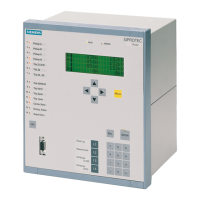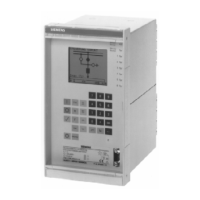2 Functions
316
7UT613/63x Manual
C53000-G1176-C160-2
currents, then that exact size can be evaluated and the violation of the limit value con-
dition can be further processed. Th settings are independent.
Derived (calculated) sizes can also be evaluated. Should the positive sequence
system from the three phase currents be evaluated, the positive sequence system is
calculated from the three analogue input quantities (phase currents) and used as eval-
uated quantity. The overall performance can be calculated and evaluated accordingly
from the three currents and respective voltages (6 input quantities).
Processing Violation of the set limit value picks up the function.
The pickup message follows a configurable time delay. The time delay is necessary
when the pickup has to have time stabilisation. The condition to be monitored should
first have sustained a certain minimum time before further action can be taken. The
time delay is also useful when the sensitive reset ration (near 1) is necessary and
therefore sporadic pickup signals should be avoided for measured quantities around
the pickup value. The time delay is usually not necessary (set to 0) for protection tasks,
except, if transient conditions need to be bridged (e.g. increased inrush currents).
The pickup drop-off can be postponed. After clearing the pickup criteria, the pickup
signal will be maintained for this dropout relay time This can be used to monitor the
intermittent events, if small gaps are to be bridged between the threshold transgres-
sions.
If the function is to be triggered, a trip delay will be necessary. This starts with an ef-
fective pickup, i.e. after an approximate time delay. Time delay continues as long as
no pickup reset is available, i.e. even during an approximate dropout relay. This
should be considered when a dropout delay has been specified (see also the setting
values in this section).
A trip command once transmitted is retained until the pickup is terminated, if applica-
ble, also via the dropout delay. The command is retained for all together set minimum
tripping times of the tripping functions (address 851 TMin TRIP CMD, see section
2.1.4 under „Circuit Breaker Data (Power System Data)“).
The dropout ration can be adapted to the requirements. When exceeding a limit value
it may only be smaller than 1, if below then only greater than 1.
Blocking Every flexible function can be blocked externally from the correspondingly configured
binary input. Pickup is not possible during blocking. A possibly existing pickup will drop
off. Delay times as well as dropout relay are reset.
Internal blocking is activated when, e.g. the measured quantities lie outside the func-
tion working area, as well as for internal faults (hardware, software).
Monitoring of measured quantities can also lead to blocking of flexible functions. One
can chose if a function, which reacts to voltage processing (voltage or power), should
have an internal blocking at a secondary measuring voltage failure. Voltage failure can
be signalled by the circuit breaker for voltage transformers, via the binary input
„>FAIL:Feeder VT“ (FNo. 361) as well as recognised by an internal voltage mon-
itoring ("Fuse Failure Monitor“, see section 2.19.1).
For a function that reacts to current processing (current or power), you can chose if
the function should be blocked for an indicated wire break in the secondary current of
the affected measuring location.
Further Interven-
tion Possibilities
Last but not least, you can influence a flexible function by logically interlinking own
signals with other internal ones, or by signals that are externally coupled via binary
inputs. The link can be created through the user-definable logic functions (CFC).
